art education
now browsing by tag
Highlighting the Positive of Covid Lesson Planning: Finding the Convergence of Content and SEL
Blog post written by Region 11 Representative, Holly Meade

Holly Meade is a Middle School Visual Arts teacher at Downingtown Middle School. She has a BFA, M.Ed in Childhood Development, and additional certifications in ESL and SEL. Region 11 PAEA rep
I am currently teaching virtually, predicted to soon to be hybrid, but anticipating anything can happen and probably will, going back with 2-days notice, wearing a hazmat suit to class, anything. I counted the amount of times I heard the word fluid during a zoom meeting, 9. Fluid is the new moist, the word is dead to me now, a Covid vocabulary casualty, joining unprecedented. As an attendance check-in, I asked my students to describe 2020 in one word, here are some responses: canceled, oof, oop, crazy, disaster, worst (most popular answer), exhausting, my personal favorite… dumpster-fire (I let that slide as one word), luckily no one used unprecedented. Whatever word you choose to describe what’s going on right now, it’s stressful and become more important than ever that we create a space that’s welcoming, supportive, and safe. An environment where content connects rigor and engagement with social and emotional learning (SEL). A meaningful convergence.
Art teachers are naturals at creating projects which spark joy, are hands-on, engage students authentically and our lesson design process naturally fits into the UbD format. Many school districts are imparting SEL into advisory blocks or guidance department lead lessons, but how do make this sustainable and creatively connect the SEL and content in an authentic way.
You can build upon what your district or individual school has been spotlighting or reinforce it. Many schools are focusing on self-management which is regulating emotions and managing stress. I examined my curriculum and lessons that I would be doing if we were in person and adjusted the content to converge with SEL domains that were not already being covered by school mandated lessons, like stress management. On a side note, I’m not managing my stress well, so I didn’t feel this was a skill I could model at this moment. I do not see recreating lessons as additional work, I see it as an opportunity to examine what is important to creating a safe supportive space that supports social and emotional learning while not sacrificing content or rigor. The examination gave me the opportunity to work SEL into the content lessons in a meaningful way. For example, when reflecting upon the dumpster fire (now one word) that is happening around us. I looked at my own children and how they were feeling powerless and without a meaningful voice. This prompted me to recreate a unit called Artists and Identity and add Voice to the mix. I found it manageable to re-create my content by highlighting just 2 of the 5 SEL domains, self-awareness, and social awareness. Because of the change in teaching format to virtual, I had to recreate how I am delivering content anyway, and when (if) we return to in-person learning, who knows what sharing supplies will look like, so it is great timing for an update. Yes, I found one positive in 2020 lesson planning. Using essential questions that tie emotions with content is another way to practice and model SEL skills while building connections.
Art is empowering. Teaching and modeling how artists use their voice for change and to highlight social issues has been amazing. We are making connections of voice and historical context using Dorothea Lange to the NBA uniforms and the work of a local artist, Russell Craig. I wish I had always given them more opportunity for discussion! We often underestimate how much our students are paying attention to the events of the world and their ability to talk about it. But like Mr. Rodgers said, “Anything human is mentionable and anything mentionable is manageable.” Taking time to create a safe, supportive space is essential for building an environment where students can connect and discuss challenging feelings, which teaches, models, and gives students an opportunity to practice SEL skills like empathy. We do need to evaluate our environments and do everything with compassion. Not just in Covid class, always in our class.
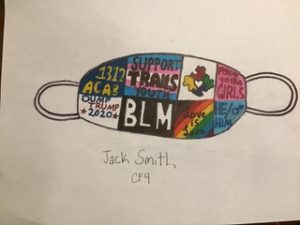
Intro design project building voice, identity, and empathy by letting others see our voice and letting someone else into your world
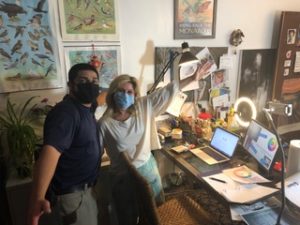
Embracing the chaos with the Comcast technician 20 minutes before hosting virtual Back-to-School Night
I’ve been teaching for a while now . . .what’s next?
I’ve been teaching for a while now . . .what’s next?
Discovering what opportunities exist for Art Educators when considering Master’s Programs.
So you have been teaching for a while now and you are considering what is next? For many of us, teaching is a way of life, and seeking ways to better our practice is simply intuitive. But deciding the best way to acquire that learning and what those extra steps will do in the long run can be difficult to answer. My name is Ben Hoffman and I am the Visual Arts Teacher at Kutztown Area High School. Since graduating from Kutztown University in 2015, my journey has taken me to Philadelphia, Baltimore, and back. I have been incredibly fortunate to teach and work in museum settings, galleries, community arts centers, summer arts programs, and public-school settings. In addition to my range of experiences in teaching, I currently serve as the PAEA Region10 Representative as well as chairman of the Kutztown University Arts Society.
As an Art Educator, you are equipped with far many more talents and experiences than what our certification deems. Teaching K-12 is merely one of the many rewarding opportunities that we have available. This past year, I successfully completed my fourth year at Kutztown Area High School as well as graduated with my Master’s in Art Education from Kutztown University. For many of us, working towards our Master’s in Education is often most appropriate and considered an acceptable pathway when pursuing our Level II Certification. Unlike my undergrad experience, the courses in my Master’s program were directly driven to my pedagogy and helped enrich the quality of my program. Much of any undergraduate program is directed towards the understanding of pedagogy and curriculum while my time as a graduate student applied that theory to practice. From rewriting curriculum, developing new courses, embodying a new mindset for teaching, and advocating for our growing program, my experience as a graduate student was unbelievable.
Regardless of the path that you may take, it goes without saying that it will take time and energy. I was highly motivated to learn just as much as I wanted to move up on the pay scale. But just recently, I stood at the crossroads of no school and yearning that desire to continue to grow. This is when I then contemplated other master’s programs and even my doctorate. Now that I have my Master’s In Art Education, what more can I do?
Connecting with people and establishing those relationships is the foundational piece to making any impact. Now having my Masters in Art Education, I am considered qualified to teach in non-traditional settings, serve as a nonprofit program director or even an instructional designer. Each of these professions seemed equally interesting, but I still wanted to know what more was available. This is when I stumbled upon a Master of Arts in Arts Administration. Unlike the education world, Arts Administration extends opportunities to individuals who are equally as dedicated, talented, and passionate as the artists and audiences they support.
The nonprofit arts sector generates nearly $170 billion in economic activity each year according to the America for the Arts economic impact study. Because of this economic and political impact, the public sector, arts, and cultural organizations are increasingly seeking trained professionals to provide vision and leadership. (Kutztown University, 2019) While teaching is one of the most rewarding fields there is the experiences that could be acquired from such a unique program that sparked my interest and felt applicable to the events our district puts on. I saw this opportunity as the key to my success in being able to learn and value the connection I share as an artist, educator, and advocate. Whether coordinating large-scale festivals, serving as a museum or gallery director or simply coordinating community events, this was the next step in my journey as an art educator.
Often a master’s program can feel daunting and overwhelming, but from my own experiences, that deep investigation of the arts and its cultural impact throughout time and across cultures have significantly impacted the person that I am today. Since graduating with my Master’s in Art Education, the excitement to grow as an educator has equally fueled my artistic practice and understanding of leadership. Furthermore, having that deepened understanding of our roots in history has helped shaped my appreciation for our field and the impact we continue to make. I would be remised to look back and appreciate all that every art educator has done to pave the groundwork for my future.
While I begin my second Master’s, I continue to question all things and continue to seek the most meaningful connections for my own classroom. While writing papers and reflecting may seem like much of any graduate program, the conversations between like-minded peers in the field are incredibly valuable. Furthermore, serving as Chairman of the Kutztown University Arts Society has challenged my own best practices and demanded that I view the Arts from a unique perspective. While teaching comes with its own set of principles and expectations, leading a group of professionals who each come with a diverse set of experiences and skills has its challenges. It is those difference and range of perspectives that cultivate a healthy and successful arts organization. It is incredibly interesting to see how my perspectives as a teacher are often valued in these new settings when working alongside those in higher education.
It is never an easy decision to make when picking a program. Every district will have different procedures and should be considered when selecting a program. I am incredibly fortunate that my district values teachers to continue their education. While loans and time may be a burden, know that there are countless opportunities and ways in which you can tailor the best program for you. I was determined to finish in three years. For others in the program, there was a range of flexibility. Some students were those who decided later in life to pursue their master’s while some students had transitioned directly from their undergraduate program full-time.
Regardless of the path that you may decide or the timeline you establish for yourself, know that you will never regret the experience. Any graduate program you choose will demand that you set aside time to work and reflect, but just as you now actively participate in PAEA, you will have no problem in accomplishing this goal. For many, just like myself, you may never know where the Arts will take you, but as long as the Arts are alive and healthy, there will be nothing but success in your future. Every story will be different. I am incredibly grateful for my experience as a graduate student and look forward to my time as an Arts Administration student.
I hope that my story inspires you to take that next step in whatever your journey has in store for you. No matter the path, the Arts will always be there as will PAEA to support you in all professional development endeavors. If you should have any questions, comments, or concerns, please do not hesitate to contact me directly. I am more than happy to extend my knowledge and support each of you in the best ways that I can. Thank you again.
Respectfully,
Benjamin E. Hoffman
Kutztown Area High School
Visual Arts Teacher
bhoffman@kasd.org
Equity, Diversity, and Inclusion- Is Art the pathway to a Cultural Utopia?
This amazing blog entry is from the PAEA ED&I chair person, Lynette Brown
Equity, Diversity, and Inclusion- Is Art the pathway to a Cultural Utopia?
(The blog consists of excerpts from my personal teacher reflections, inquiries, and presentations.)
“A cultural utopia meaning that every student has a voice in the classroom, school community, and we all (educators, too) can learn about the world by seeing, listening, and connecting to one another, (especially our students).”
As a black woman of color and art educator, every February during Black History Month, I often witness the parade of culturally conscious history and art projects throughout schools and various communities. However, for me, it is a time to reflect and delve deeper into my authentic purpose as a woman of color, artist, and art educator.
Reflections
In 2006, after spending ten years at one of the more challenging public schools in Germantown (Northwest Philadelphia) where school reform, No Child Left Behind, high stake testing and A.Y.P. (adequate yearly progress) were the only motivation for many, except students. My position as the art teacher, the last art teacher was cut as a result of the tumultuous test-driven environment. I was the last “advocate for the arts” and ambassador standing and gone were all of the art programs that once served over 1000 students. Never again at Pickett Middle School would the students paint Afro-centric murals on its walls, perform traditional African dance to the calls, sounds, and beats of distant African tribes, participate in the great theatrical performances like “Purlie” led by Mrs. Pollard and Mrs. Parkinson Hall, and the choir now silent had long sung its final gospel hymn. As the building decayed -so did the arts and its relevance as a new order of education took shape and rose in the city of Philadelphia.
I left a school that used only half of the building and a class filled with supplies and students who soared when being creative. I quickly recovered despite not knowing if the students I left behind did. I took up residency at Alternative Middle Years at James Martin (A.M.Y.) school. A.M.Y. is located in the Port Richmond section of Philadelphia and is quite a different neighborhood from Germantown, historically and culturally.
The opportunity to teach and connect with students from diverse cultures would be a new challenge and opportunity for me to grow and learn as a teacher. My excitement in the weeks leading up to September was un-containable. During my first months of teaching at A.M.Y., I enjoyed watching the social interaction of students and multicultural friendships. I can recall one late October afternoon during the occasional school social, a colleague shared the following statement, “I don’t care what happens out in the real world, I like that we have a perfect cultural utopia here at AMY.” That verbal exchange resonated with me and in me for quite a while. I now began to experience a new level of discontentment. Isn’t A.M.Y -the real world? What made A.M.Y. a cultural utopia? Where are the programs and messages that foster that cultural utopia? What did A.M.Y. have that was not present in the outside world-the real world? Does the school staff model this cultural utopia? Was my colleague seeing the whole picture? Am I missing the picture?
As time progressed the observed multicultural friendships were not enough. I questioned, looked deeper and found that the multicultural message of a perfect cultural utopia was somewhat superficial. The only “authentic” effort to learn about the world by seeing, listening, and connecting to others was being driven by the students in the halls, in the schoolyard before school, and during the lunch period. The diverse student population was only the beginning. Were we (the school staff) doing enough? Where was the share fair day at AMY, which started as a cultural exchange celebration? How could we offer our students a place and voice in the school community? Where was my place and role in regard to the students in this perfect cultural utopia? Can a cultural utopia ever exist?
In the past, I believe that designing lessons that featured the backgrounds or highlighted the history of students represented in my classroom was enough to promote student voice in the classroom. It was my way of promoting equity in the classroom to others from different cultures or ethnic backgrounds. However, through my reflection, I learned that I was presenting student identity from my perspective; it was more of my teacher voice and intent. In response to the on-sought and parade of questions, I began to include more even more culturally relevant classes on my roster and provided students with collaborative projects featuring art from many cultures and lands from a first-person perspective. I once again, as I re-framed my practice to help create a sense of “a cultural utopia”; I embarked on a journey of inquiry using visual journal projects. As I tried new things to teach authentically and created more space for students in the classroom, I began to learn the importance of student voice and it’s affect in the classroom and learning.
My Inquiry Questions
“What occurs when visual journals are used as social commentary for expressing student identity within the school?”
- Can the journaling process create a space for student culture and voice inside the classroom?
- How can I promote more authenticity and originality in student response in their journaling?
- Can exploring identity issues through art journals in the classroom lead to increased student engagement and self- esteem?
- Will the inquiry in my class elicit the type of expression needed for me to learn about who my students really are?
- What is my role in fostering a safe environment to create personal art and expression?
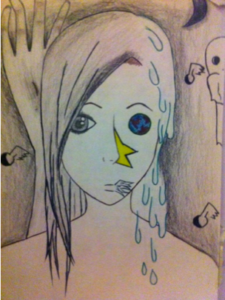
As Mark Berger states in the Culture of Quality chapter in Going Public… “…Elements that have nothing to do with curriculum have the most profound effect on the lives of children… These things are every bit as important as the curriculum.” How can we allow our students voices of identity into the school and class dialogue?
Visual Journal Project Overview
Sampling of Visual Journal Lessons:
- I Am, I Am Not T-shirts
- The Power of Words Illustrations
- Self Portrait with I Am Poem
Through the visual journal project, my students addressed themes such as bullying, prejudices, gender roles in their family, in their culture and the United States, along with the other concerns and issues that adolescents face from other parts of the world. The students discussed their journal projects (visual drawings, interviews, photographs, poetry, narrative writing, research information, etc.) and displayed the art in a final project exhibition for the school-wide community to view.
The purpose of journaling is to record, reflect, or envision, problem-solve, and purge. For years, I have used journals to transition, settle students down, begin a lesson, assess student learning and development, offer an opportunity for students to make mistakes, provide reflection, and deep thought. As years passed, journaling evolved into a larger role in my instruction, teaching, and student learning. I have unexpectedly learned so much about my students’ outside life and thoughts through journals. Often, through student journals that I have had a glimpse into my students’ true identities.
My Conclusions
Students serve as the best authorities on telling their stories. So often, others speak to and for students and make assumptions on what the students’ realities and communities are like to the larger world. As an educator, I learn best from my students firsthand. A cultural utopia meaning that every student has a voice in the classroom, school community, and we all (educators too) can learn about the world by seeing, listening, and connecting to one another, (especially our students). In this cultural utopia, there is respect for learning about the world and one another’s world through inquiry. Seeing our students’ cultural capital allows for valuable learning experiences in the art room and work towards promoting inclusion. This is a way of understanding our students come to our art classrooms with a plethora of valid and valuable experiences, traditions, and knowledge. As every September and February approaches, I once again have recaptured that un-containable excitement knowing that a culturally relevant classroom driven by my diverse student population can move A.M.Y. closer to a cultural utopia.
By Lynette Doreen Brown
Art Teacher, Philadelphia School District
M.ED, N.B.C.T.,
Equity, P.A.E.A. Diversity, and Inclusion Committee, Chairperson
Interdependence Hexagon Project: You are Invited!
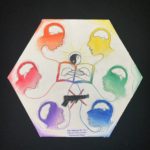
Blog Post from Beth Burkhauser and the Interdependence Hexagon Project
The Hexagon Project is an international visual arts initiative. Our mission is to spread the idea of Interdependence through student- and community-created hexagons. The hexagon is the metaphor for interconnectedness and, since our founding in 2016, over 10,000 artworks have been made worldwide. We are launching our 2020 project in October, our 14th year!. Themes of social justice, peace, global citizenship, cultural diversity, identity, and environment are expressed through the power of the arts.
Our 2019 Theme was Transforming Conflict and our Eastern Regional Exhibition [PA, NY, NJ, DE, MA CT] opens in Scranton, PA on September 6 and runs through the month.
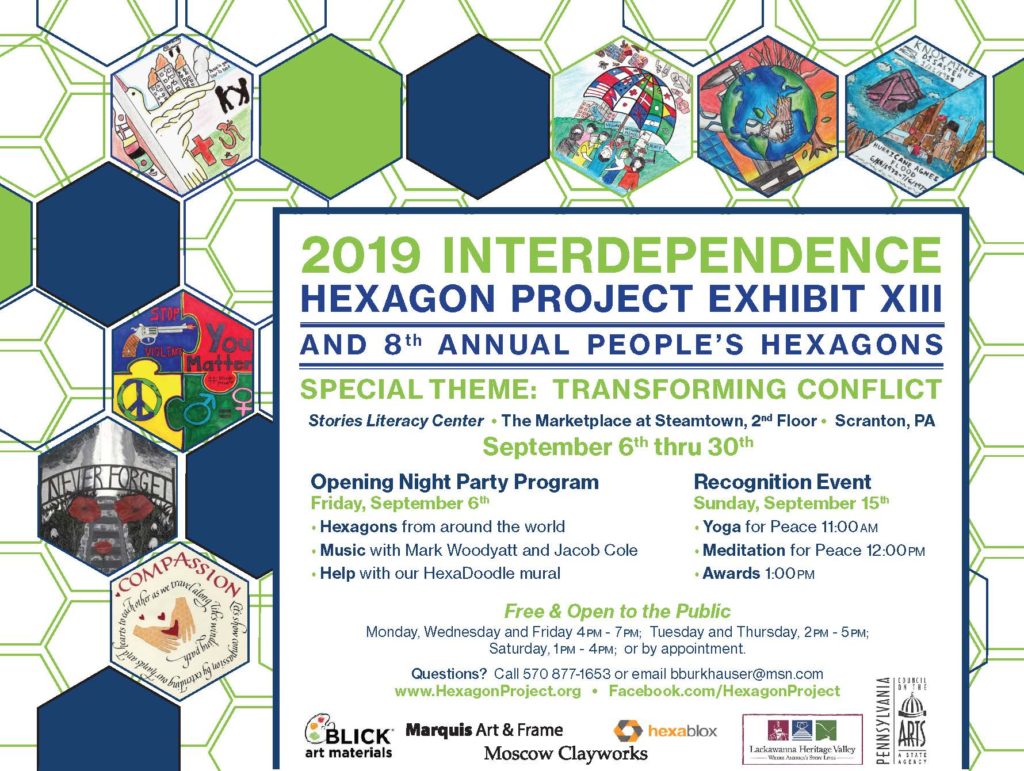
The Project is free, WEBSITE [www.hexagonproject.org] offers free resources, templates, lesson and unit plans, worksheets, video, and PowerPoints to introduce the Project. Open to all ages, all media, ripe for strategies such as Choice, Integrated Curriculum, TAB and 21st Century skills, align with Next Gen Arts Standards. Teachers join and then upload artworks. 2020 DEADLINE: June 30, 2020.
NEW: we have a searchable Online Gallery where all hexagons can be viewed and a Blog-space which will feature global teachers’ stories about how, why and where hexagons are made plus opportunities to connect with others.
WANTED: participants for our 2020 Project and 2020 Project SPECIAL THEME: DIVERSITY. Brainstorm ways to think diversity! Could we today see the challenges of inclusion and acceptance of difference as the challenge of a process of transformation? Fertile ground for a shift of mindset with the infusion of new ideas attitudes and focus that results in outcomes that can transform our future on this planet.
OR…
Perhaps consider DIVERSITY as a self-selected problem-solving design thinking process that resembles an alchemical transformation – as in the medieval attempts to convert base metals into gold.
Fertile ground for a shift of mindset with the infusion of new ideas attitudes and focus that results in outcomes that can transform our future on this planet. Students envision this process using hexagons and share it with the world…
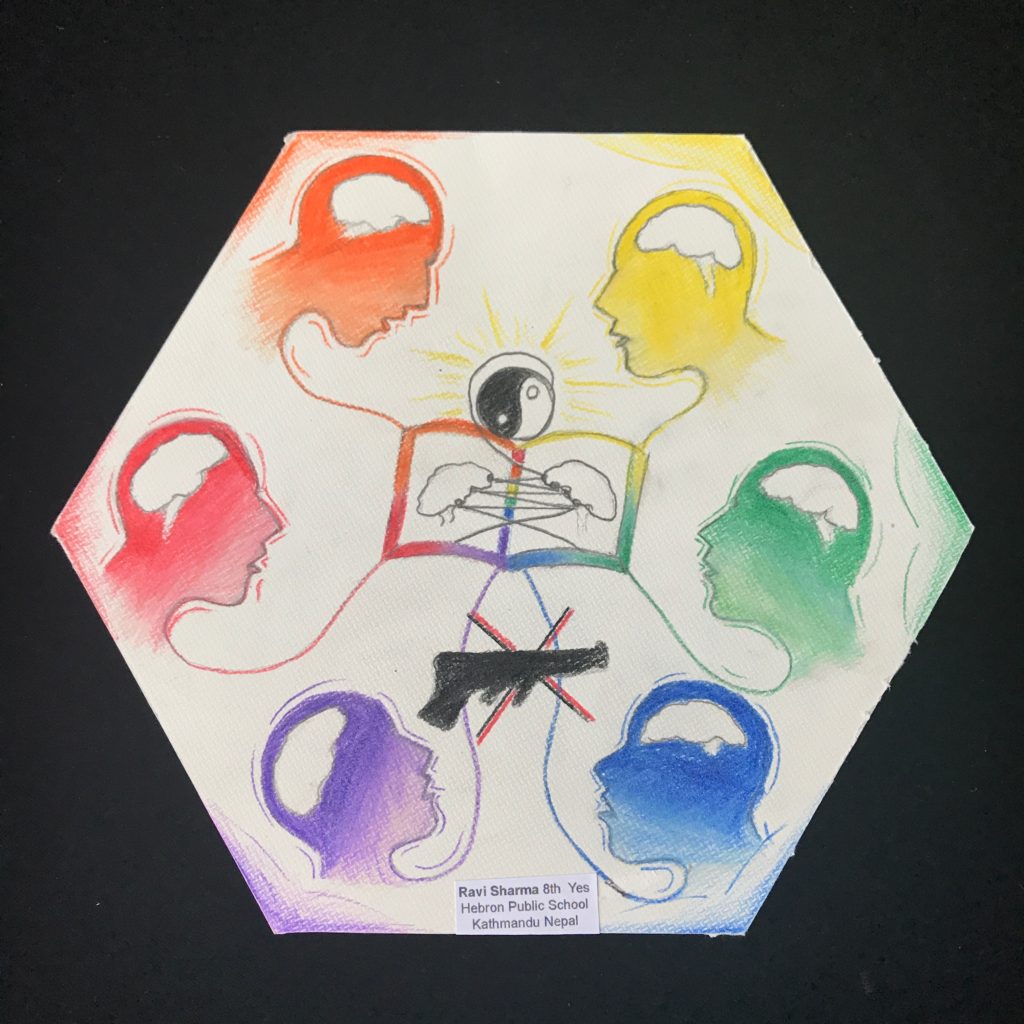
DIVERSITY can also refer to diverse learning styles, cultural diversity of art, music, dance, food, etc, Fusion. Bio-Diversity of plant and animal life as well as human and technological diversity – using the multitude of available and developing tools for good.
Here are some resources for you:
https://www.tolerance.org/topics/race-ethnicity
Resources about living in a diverse world.
Some sections of resources on diversity from Vanderbilt University
Lastly: This Hexagon Flying Pencil came from Kingdom Kids International School, Nigeria [Olaniyi Sunday Olaniran, Art Teacher]! It is meant to travel and house hexagons! In 2019 it took a beautiful metaphorical journey from Nigeria to Howard Gardner School, Scranton [Melissa Cruise, Art Teacher] to Stephen Girard College, Philadelphia, PA [Christine Enedy, Art Teacher] and we are looking for other venues for 2020! Contact the author if interested.
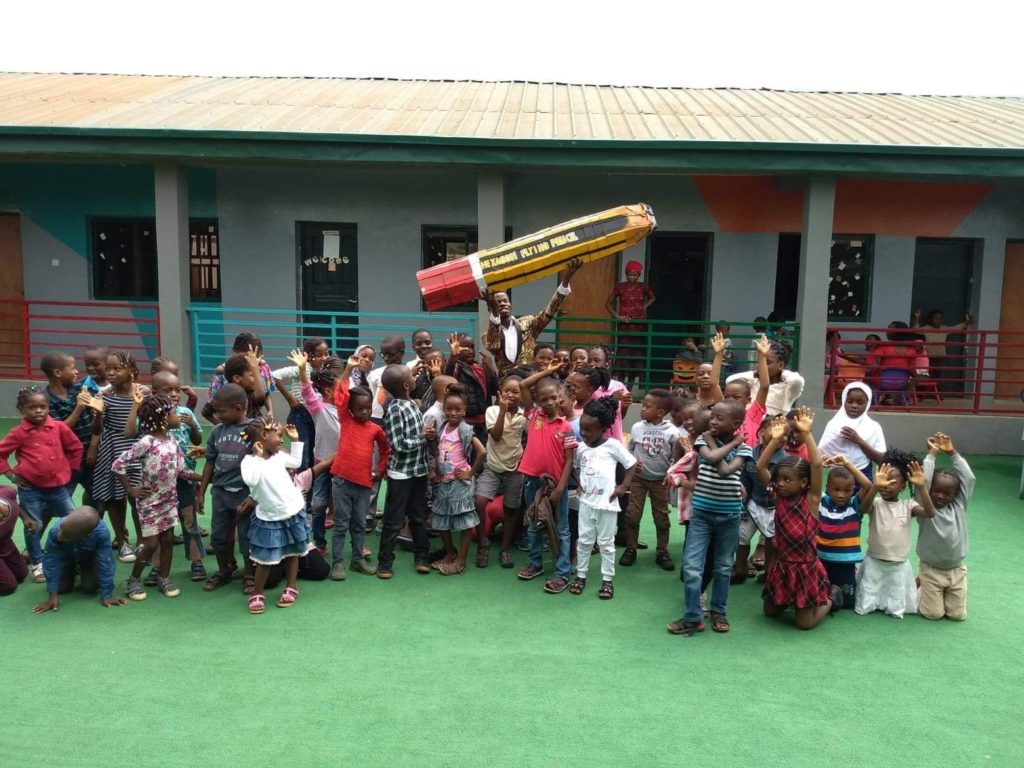
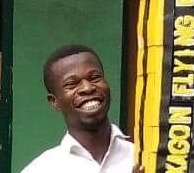
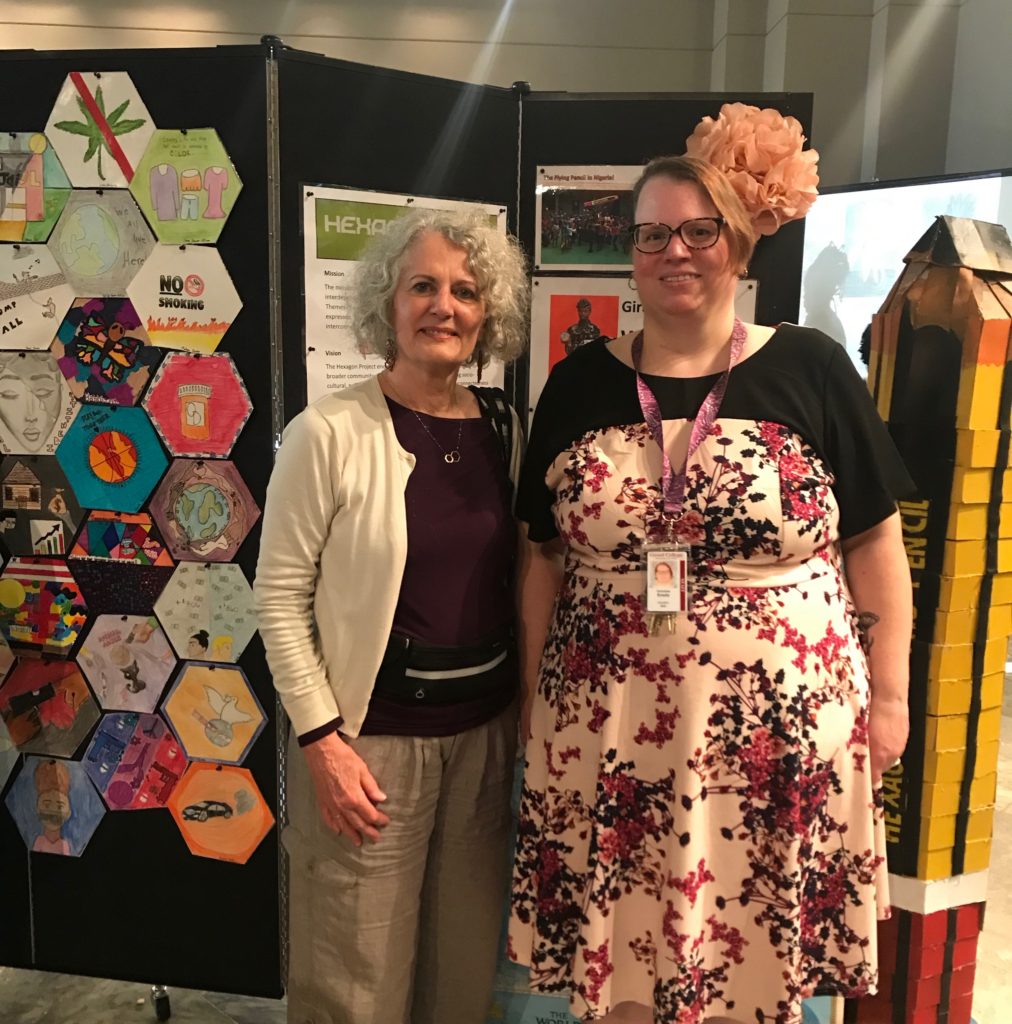
Beth Burkhauser is Adjunct Professor, Keystone College Art Education.
She is a 35-year veteran art educator in Pennsylvania Public Schools and
Founder of the non-profit, Interdependence Hexagon Project.
She was named 2016 NAEA Educator Emerita and is a
PAEA Fellow
Contact: www.hexagonproject.org
bburkhauser@msn.com
570 877-1653
Creating a Staff Mural & Building Morale
This blog post is contributed by Jes Noel. Jes
As art educators we create art with our students however have you ever considered creating art with your peers? And I am not talking fellow art teachers I am talking about the other educators in your building that DON’T teach art! Well, I am here to tell you it is possible!
This past 2018 – 2019 school year I created a staff mural with my fellow 70 educators, paraprofessionals, administration, secretaries and custodians. With the help of my building principal, we found time in six-morning meetings throughout the year to create our mural with was unveiled in April during our annual Celebrate the Arts Night. Our inspiration came from the street artist Kelsey Montague and her #WhatLiftsYouSchools movement.
First Morning Meeting:
I prepared a PowerPoint to explain to staff what our initiative for the year exactly was. Our Goal: create a staff mural to gift to our students in April inspired by Montague’s wings which also tied into our new social media initiative. #ironkidssoar
Second Morning Meeting:
Staff painted two pieces of paper with acrylic paint which would ultimately be turned into 4 feathers per staff member. Staff was limited to red, orange, yellow, blue, green or purple paint.
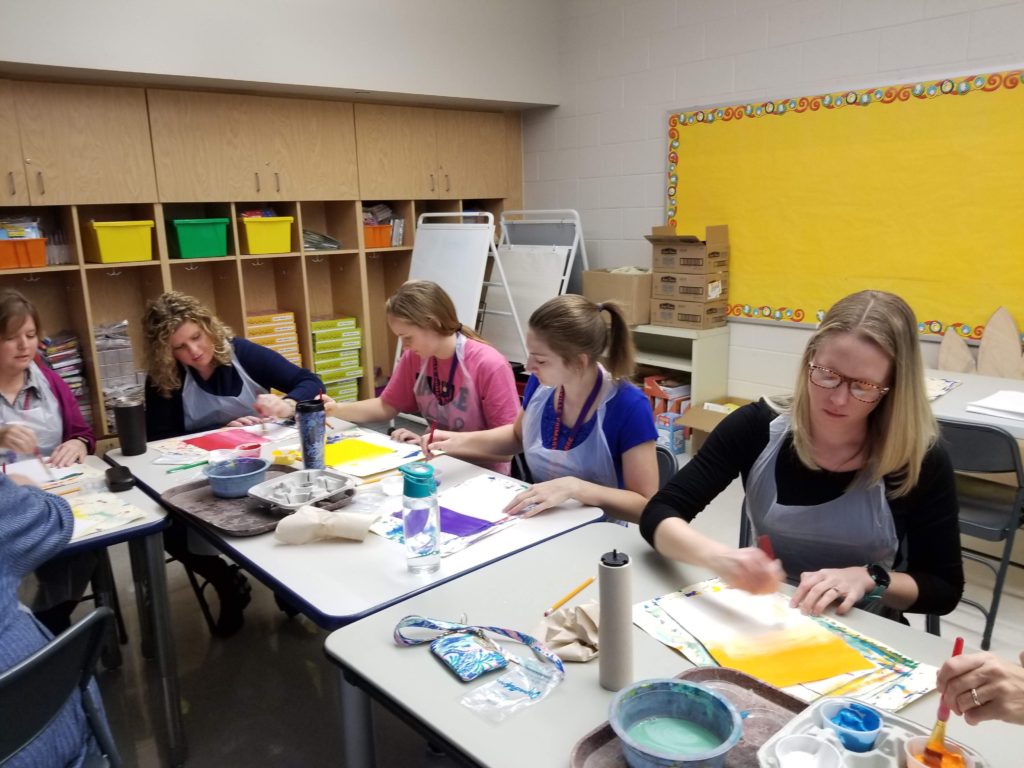
Third Morning Meeting:
Staff were introduced to the Zentangle Method and practiced Zentangle on a 3×3 square.
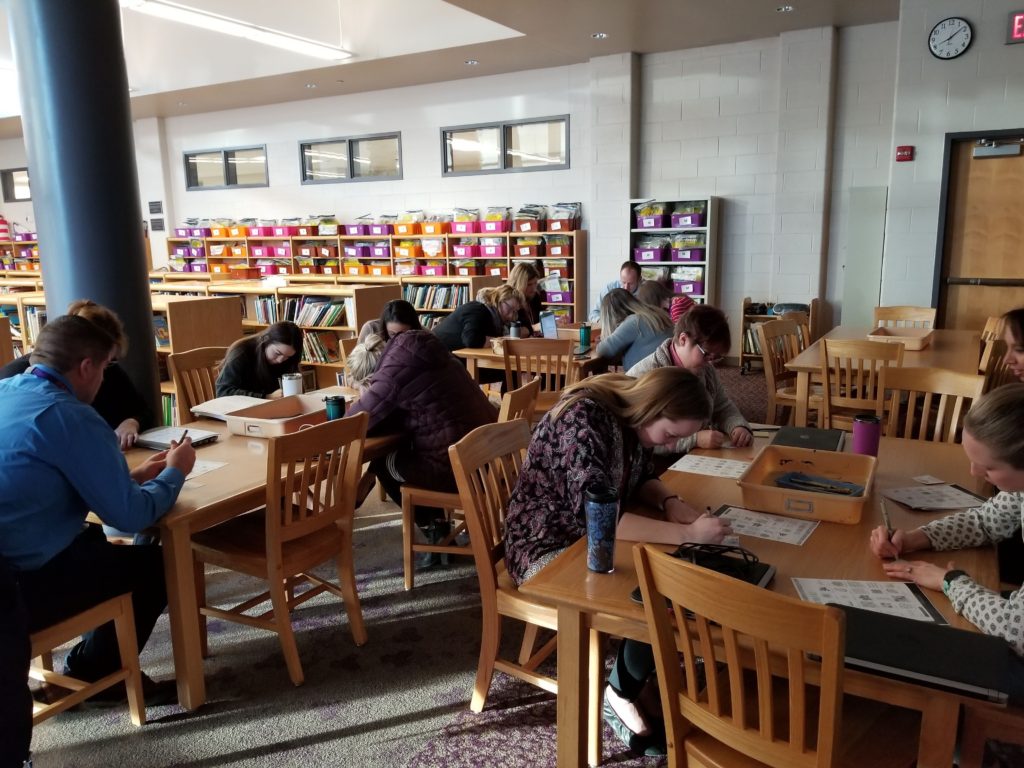
Fourth Through Sixth Morning Meeting:
Staff Zentangled two of their four feathers for the mural. Feather stencils were provided for continuity along with multiple handouts and examples. The other two feathers remained blank.
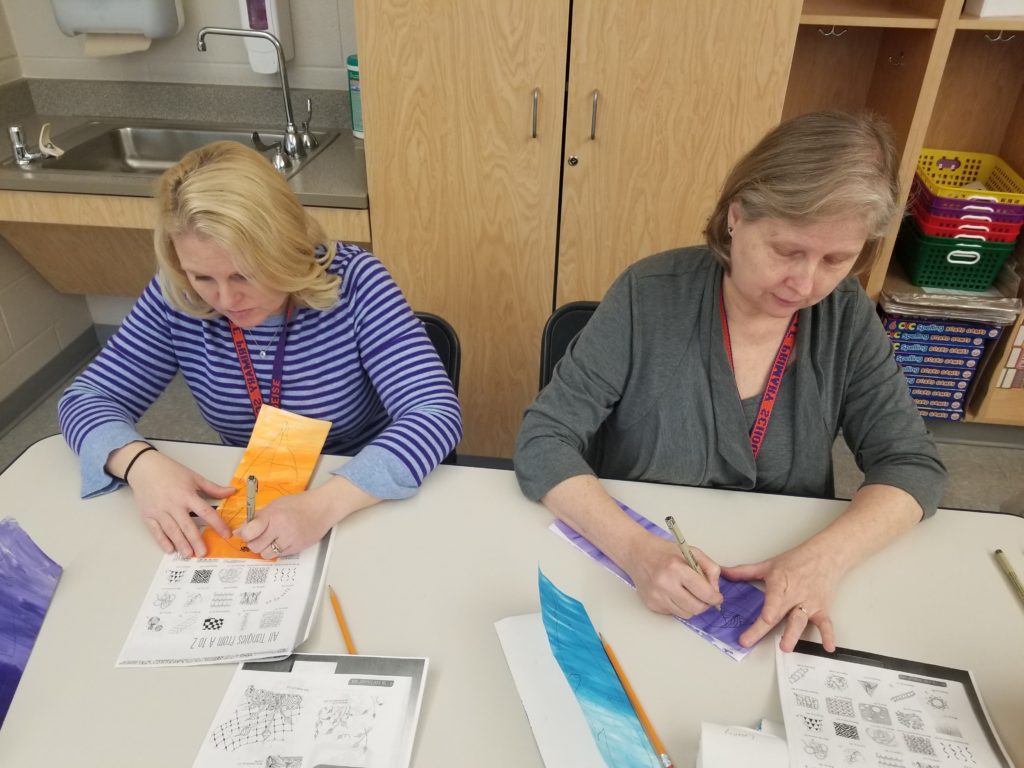
Upon completion of all the feathers after the sixth-morning meeting, I and a fellow first-grade teacher began the process of laying and gluing all 280+ feathers onto plywood that we had cut into the shape of wings.
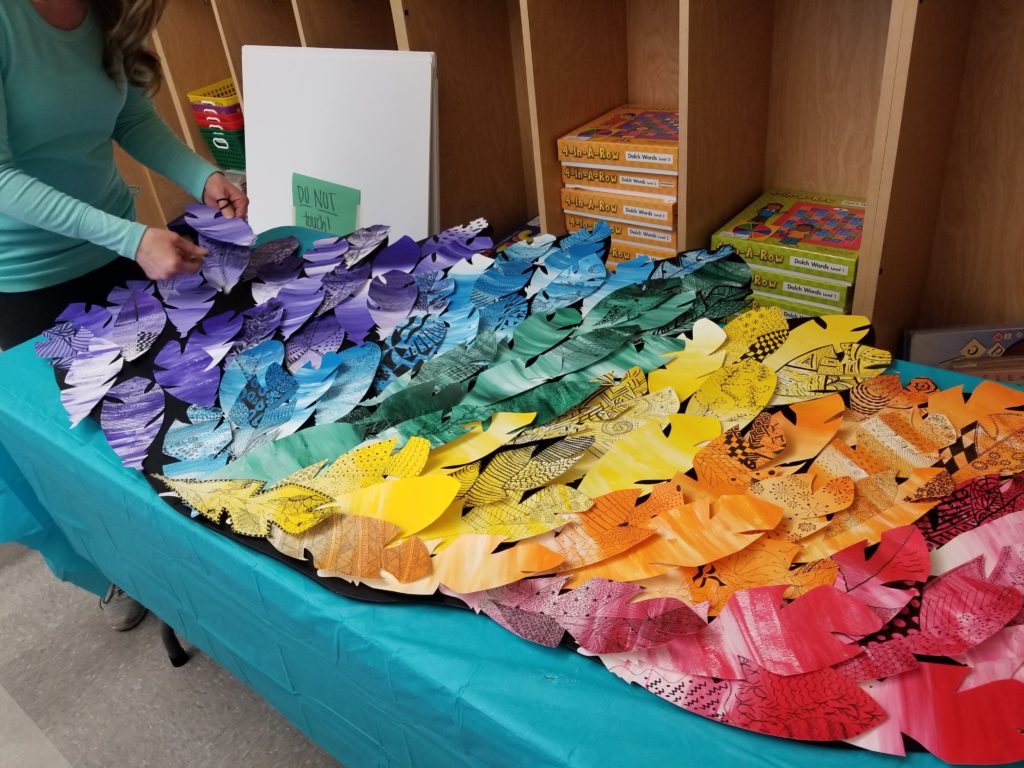
After many, many, MANY coats of Mod Podge, the wings were ready to hang! The staff had voted to entitle our group mural “At DPS, Our Dreams Take Flight.” With the help of our maintenance department, we hung our wings in the main hallway for prime viewing and interaction.
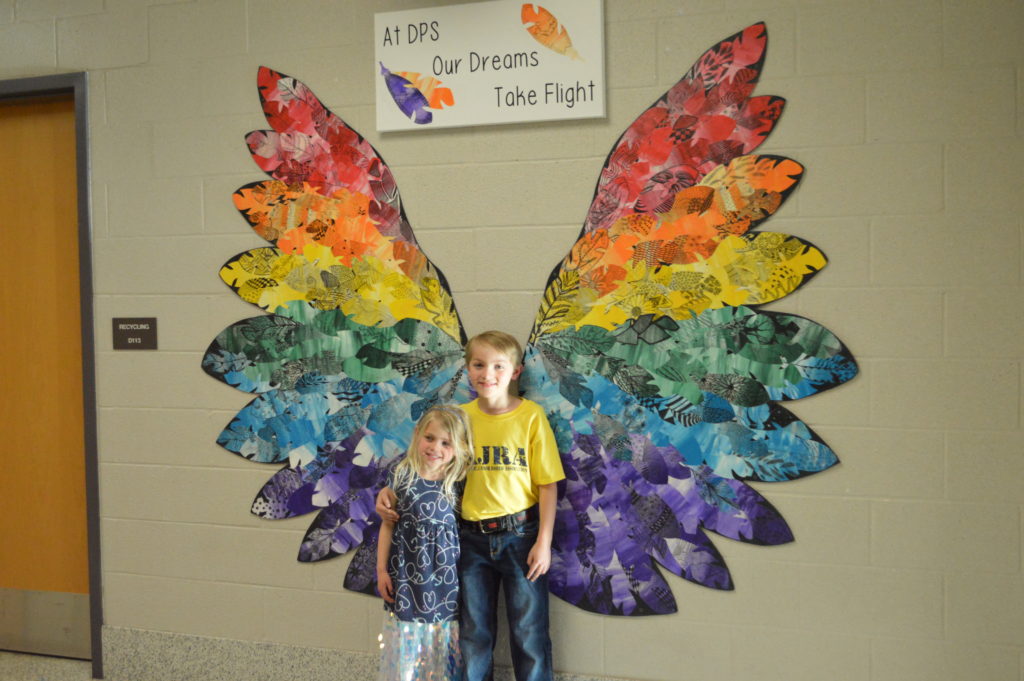
Balancing the Teacher and Artist in Me, By Jackie Thomas
Balancing the Teacher and Artist in Me
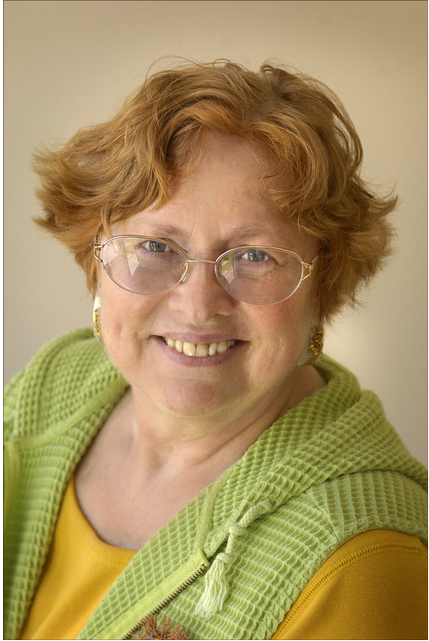
As a Fibers Artist, time has always been a challenge for me. Just plain living takes so much time, and when a teaching career is added, there is little left for the creative process and studio work. I thought I was not really productive in the studio while I was going through challenges of balancing home and school. But in retrospect, I realize I really was productive by channeling my creative energies in a number of ways:
As a brand new teacher, fresh out of college, and having already decided to specialize in Fibers. I packed up a project bag with a pre-woven rya rug backing (on which I drew a simple design), some yarns, a measuring tool, and a large tapestry needle. I kept the bag at school, available for the snippets of time available to work on the rya rug during faculty meetings and in the faculty room (I was told that teachers thought I was stuck up if I never left my classroom, so I scheduled a couple of periods a week to talk with teachers in the faculty room and did my planning at 5:30 in the morning and at home). It was a bulky bag that I lugged around, but I learned about trying to fit into the building and being a member of the larger school community. I believe it took all year to finish that Rya Rug.
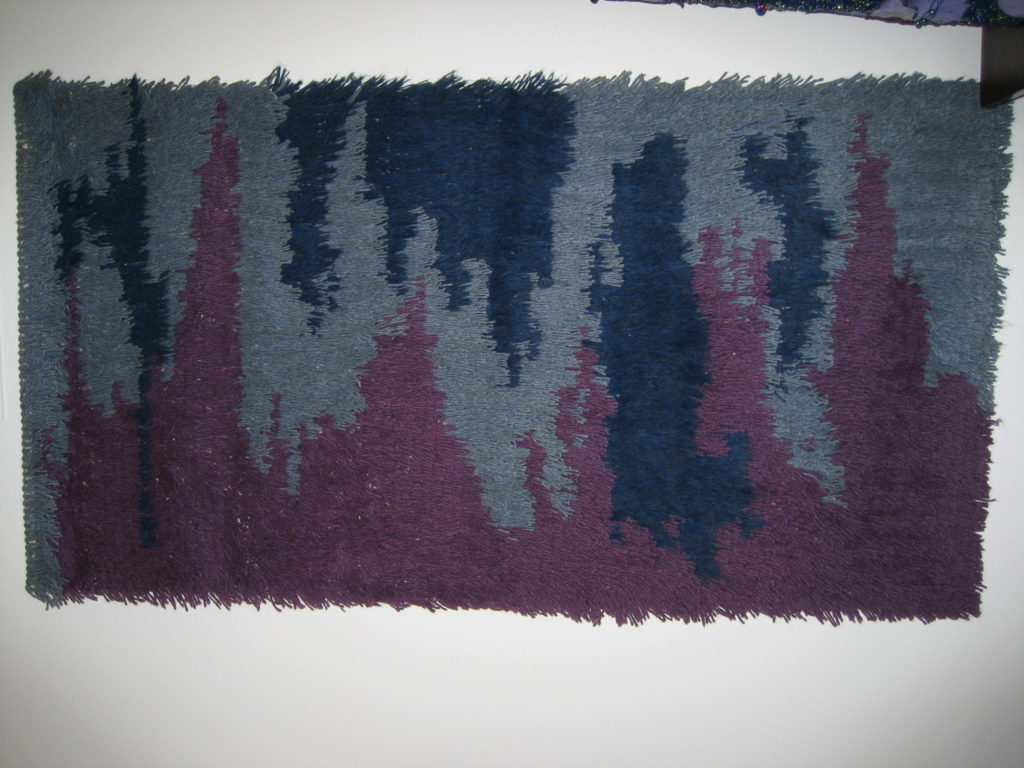
Time to balance teaching and art making didn’t shift any over the years, and I decided that I wanted to complete more than just one artifact in a school year. I looked for projects that would not require much of an investment in time. I tried jewelry making for a couple of years. A new bag of materials accompanied me to meetings and on car trips when someone else was driving.
Feltmaking jewelry:
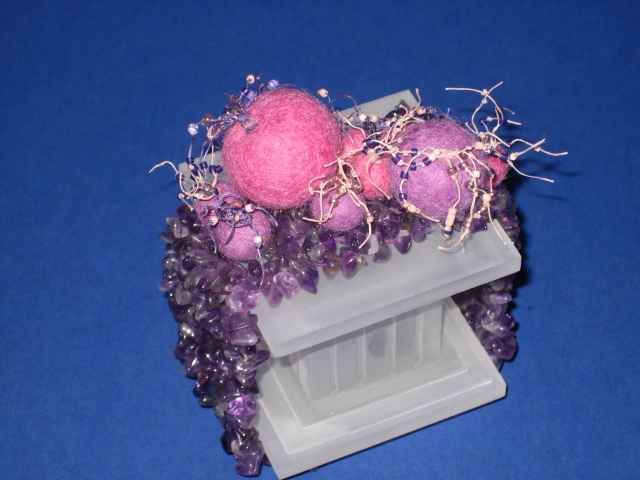
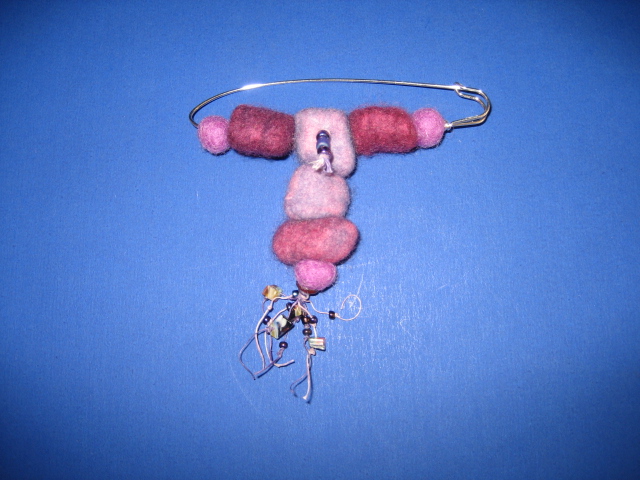
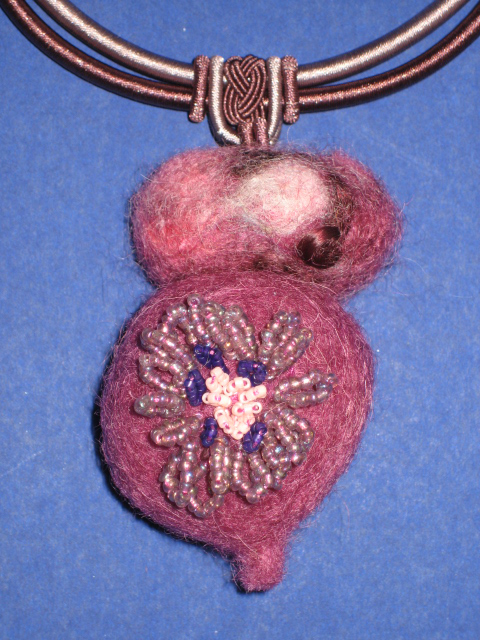
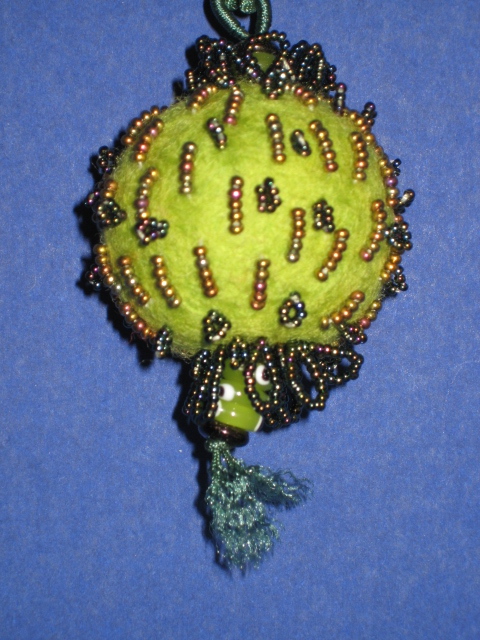
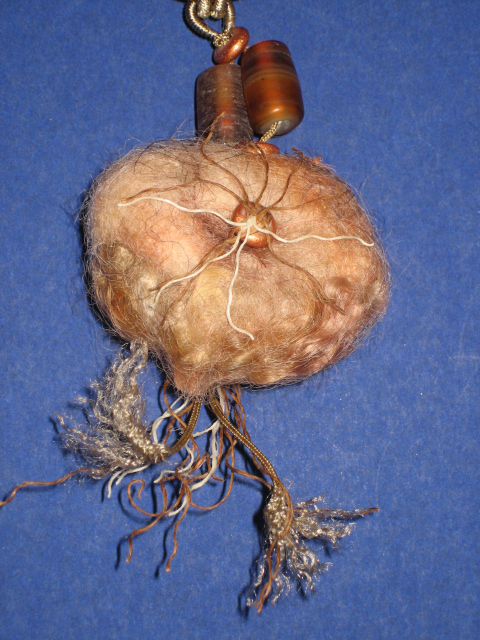
Waxed linen coiling/twining jewelry:
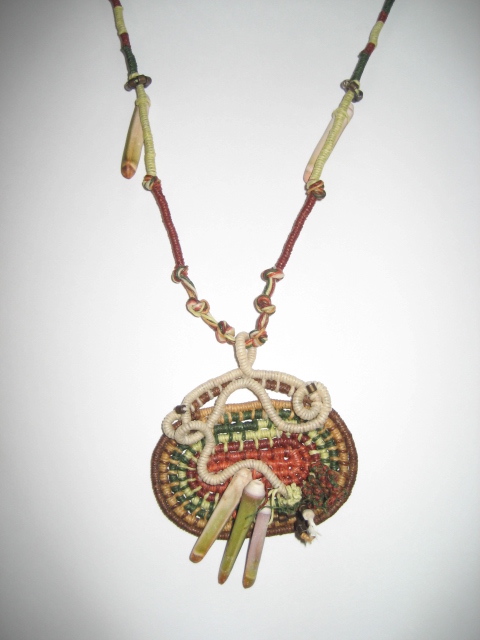
But I eventually decided I didn’t really find jewelry satisfying – too much assembly. And, fibers jewelry making was not really transferable and informative to teaching my students.
Quite by accident I began to make miniature dolls as fetishes and found that quite satisfying for more than ten years. My sister and I attended the American Crafts Council Baltimore Winter Market every year, and I bought one tiny wearable fetish animal doll from An African doll maker each year.
African Animal Fetishes:
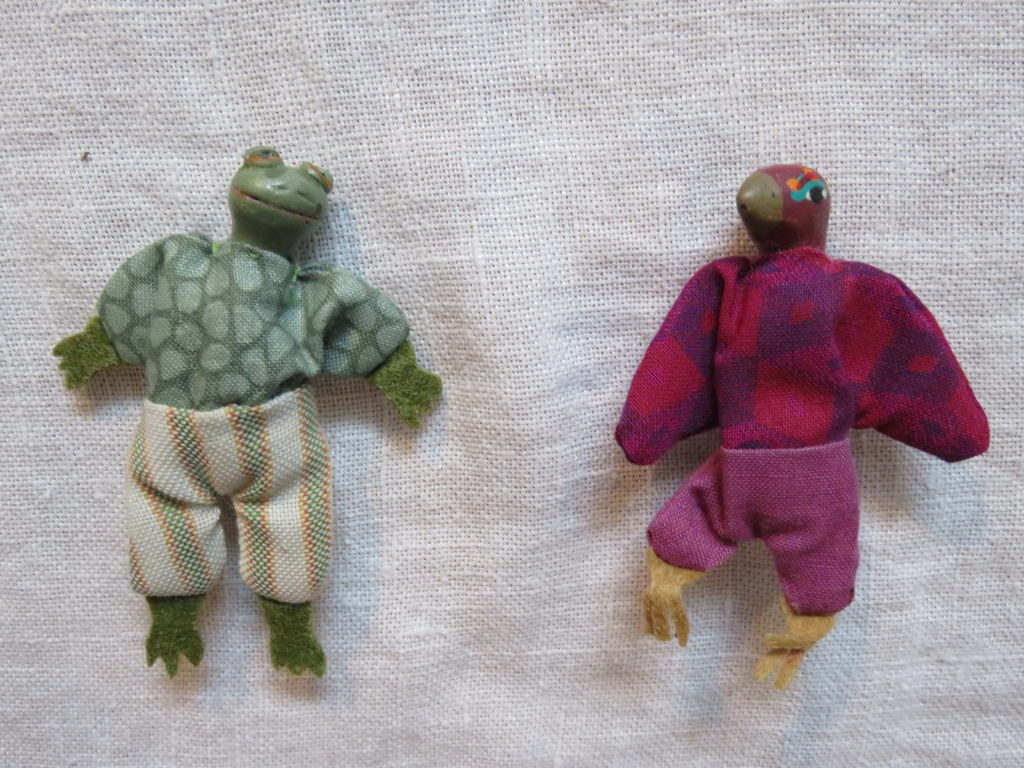
“A fetish is an object of magical powers. It is a guardian chosen by you. Once you have chosen your fetish you must promise to faithfully care for it. You must keep it in a warm, dry place and feed it one grain of corn or rice or bean each year. In return, it will insure you good health, clear sight, protection against injury, success in hunting and trading, and abundant love.”
After the fetish artist moved back to Africa, I went through fetish withdrawal, and I began to design and make my own little fetish dolls. I have worn a fetish every day over the past 40+ years.
I usually worked on a series of fetishes of one color/fabric but each with it’s own look/design (one to keep and the others to share). I tried to complete one step in each sitting (i.e. trace the pattern onto the cloth and cut them out; sew the fetish shape with right sides of the cloth together & leaving an opening along one leg; turn the cloth fetishes right side out, stuff them and stitching them closed; embroider the faces; add hair; clothe one fetish at a time).
Some of my Fetishes:
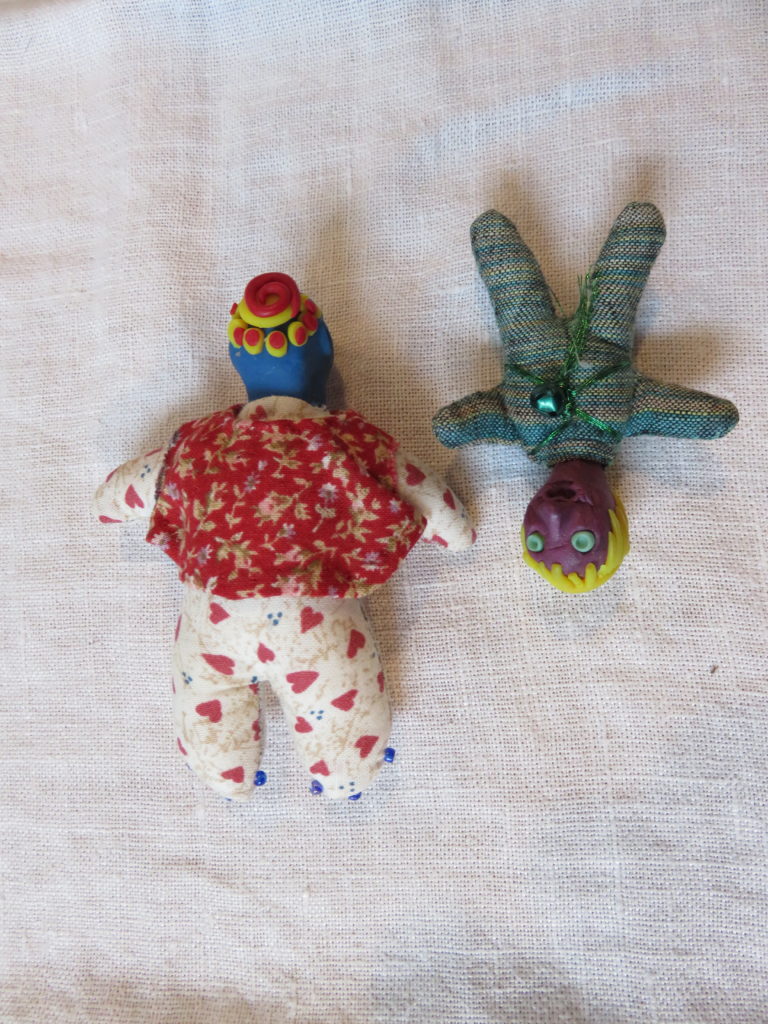
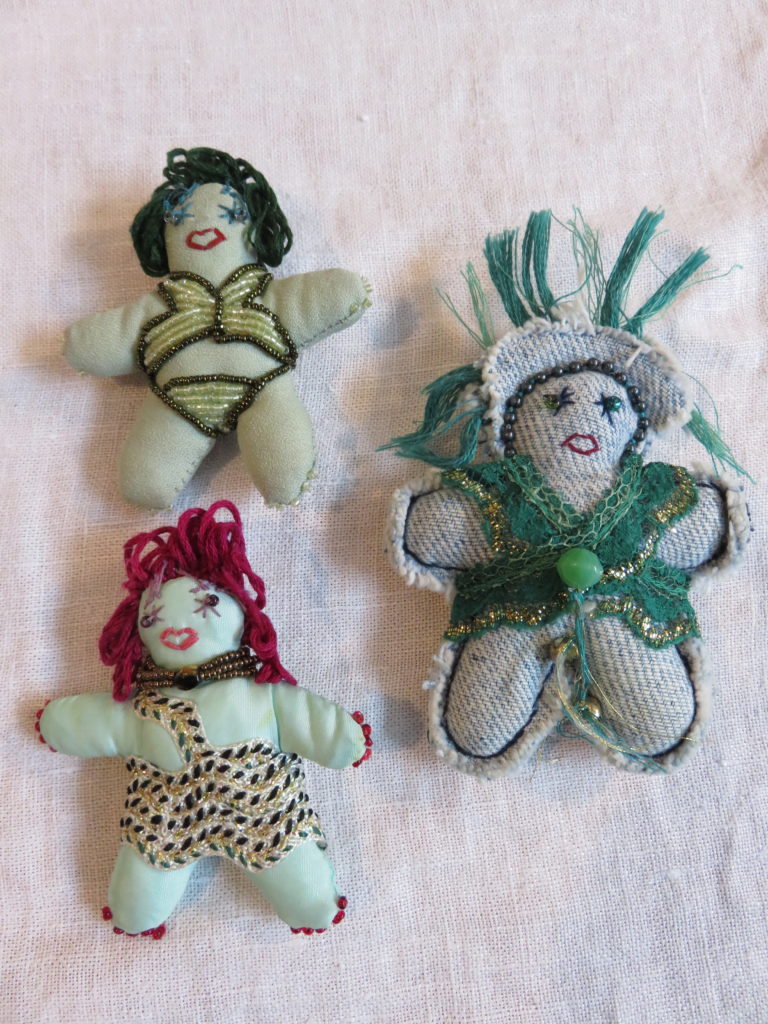
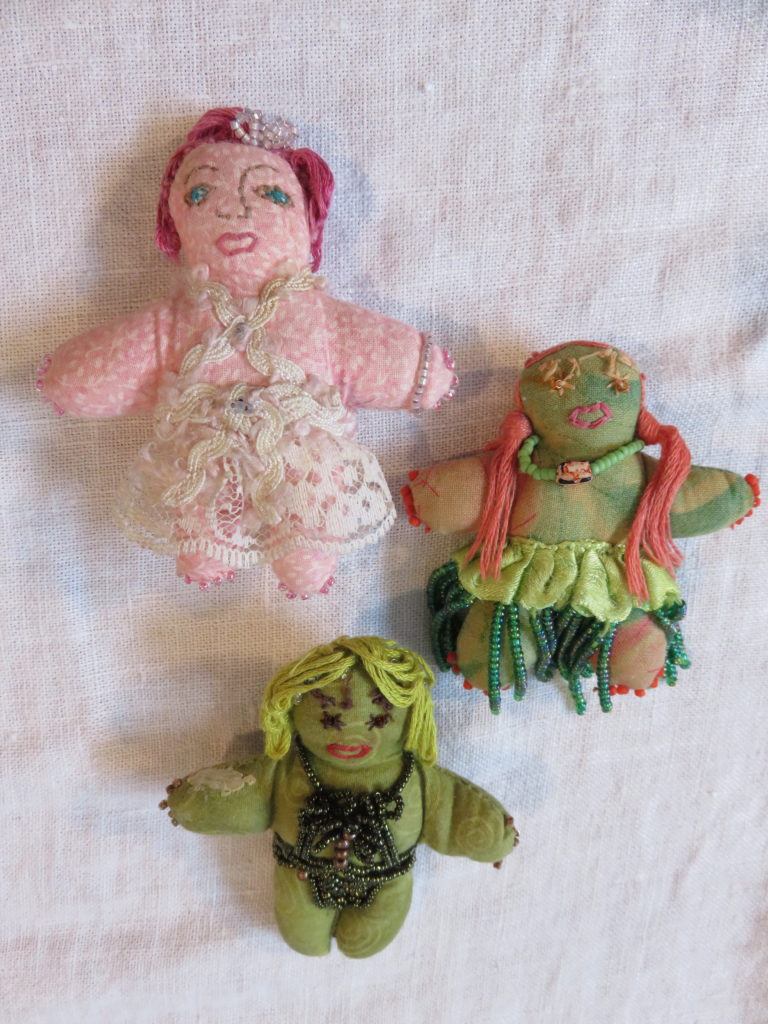
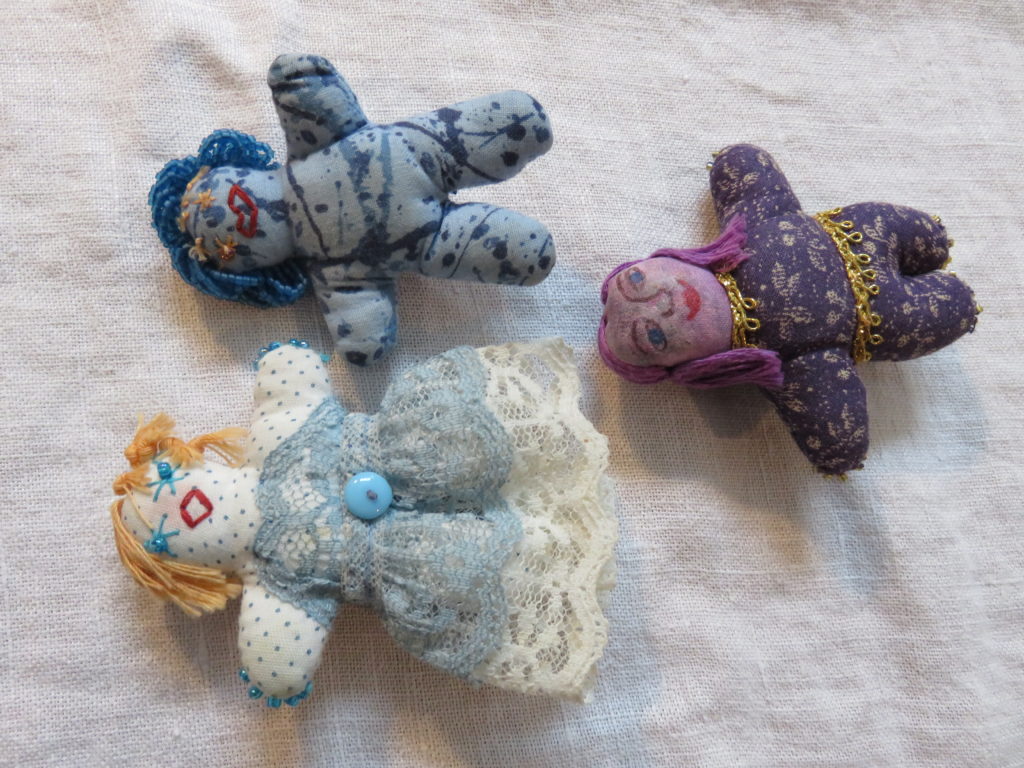
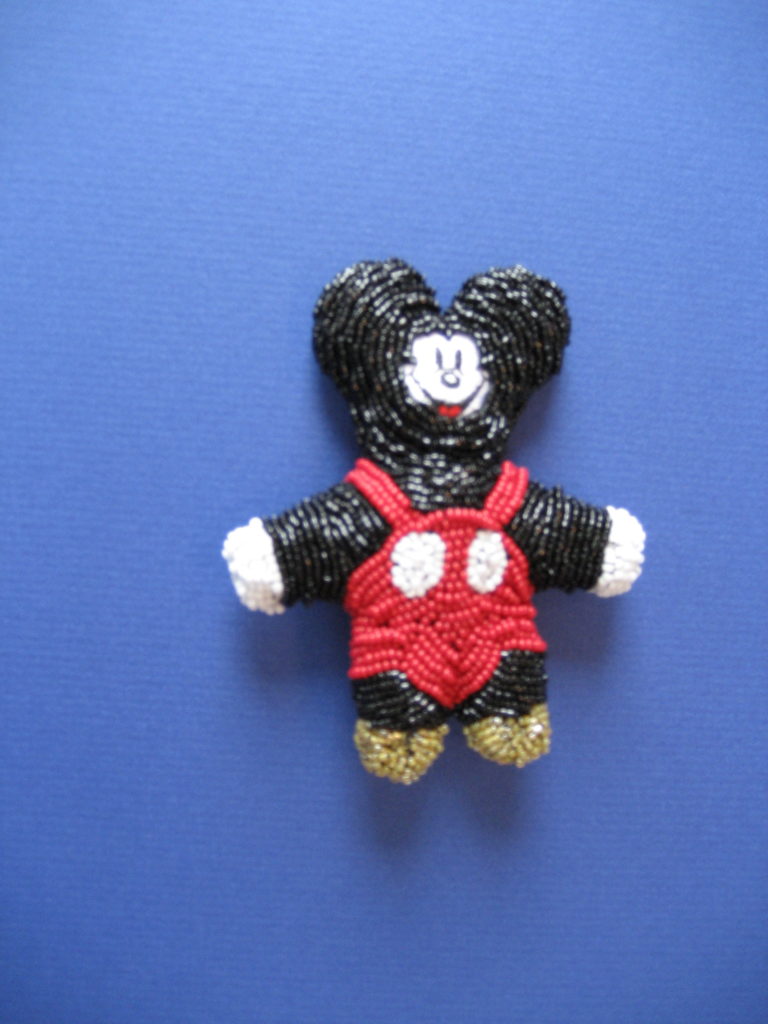
An AHA! Moment occurred when I realized I had boxes and bags of process and project samples for feltmaking (and other fibers processes). They were already of my own hand and design. I pulled them out and began to assemble them into larger sculptures (a technique I then used with students as well). I also challenged myself to create one-a day miniature artifacts to be assembled later into larger pieces.
“Pulls”
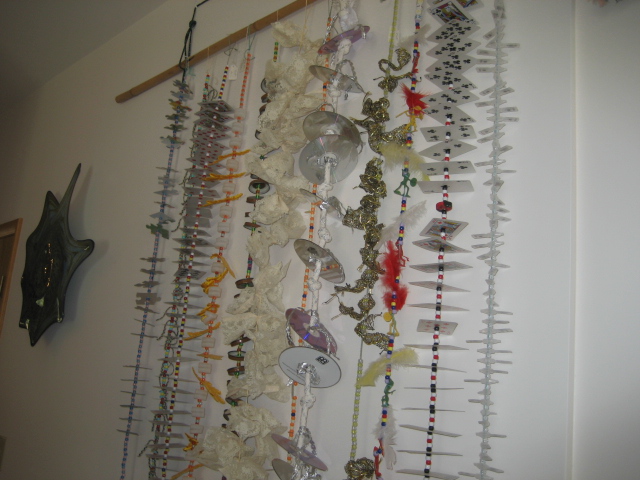
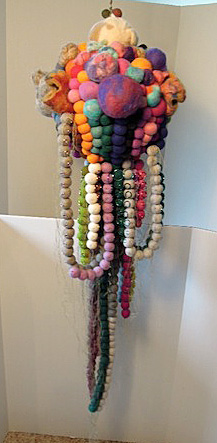
“It’s An Octopus!”
The challenge is the time. I dedicate time (usually weekend or evening) to get a project concept defined in my sketchbook and to organize materials. I look at my schedule to see where I might capture unscheduled time. And I always have a bag or a box loaded and ready when time suddenly and unexpectedly becomes available. I have rules:
- Never let my own art work interfere with planning for my classes and experimenting with materials and techniques before teaching them. Planning is important.
- Never work on my own art during teaching time.
- Request someone else drive whenever possible so I can work on a project during the trip.
- Always have a journal or paper to write down ideas, things to remember, and to record discoveries and things I learned.
- Collect materials and experiences on every walk, vacation, and opportunity.
- Never throw away project failures or demonstration projects. They may serve another purpose later. At the very least, failures help me remember how NOT to do it (because otherwise I will usually do it the unsuccessful way over and over again).
- Teaching others is a prime way to learn and improve my own skills.
- There is always something to be learned, even in the most repetitive experience.
- ALWAYS be ready to work on a project…. i.e. ball gown components created while sitting at Little League games.
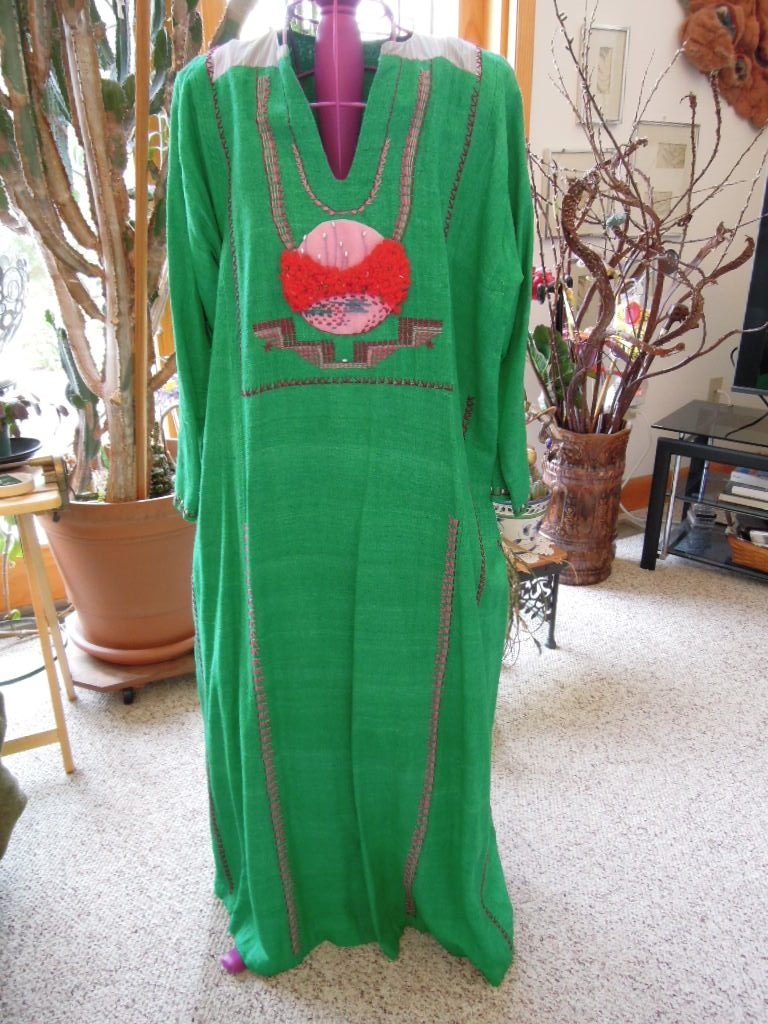
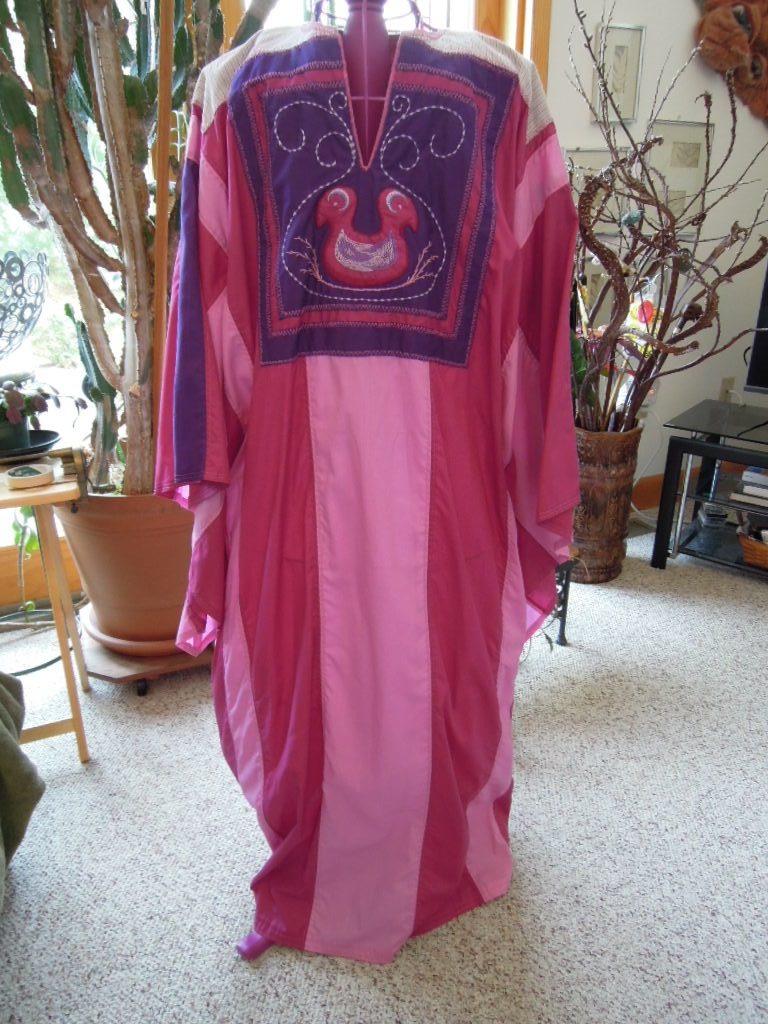
If nothing else inspires, I can always redesign/embellish wearables from my closet.!

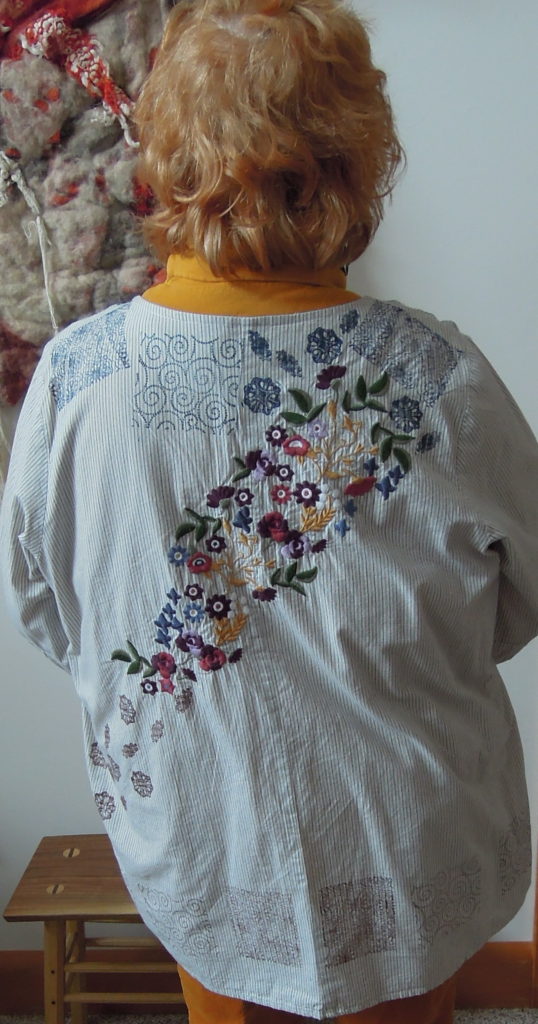
C’est Finis!
Spring Symposium at Moore College of Art and Design with School District of Philadelphia Art Teachers!
Guest post by:
NAEA Special Needs in Art Education President-Elect
On May 18th, 2018 Moore College of Art & Design’s MA in Art Education with an Emphasis in Special Populations program hosted its annual Art Education Symposium titled “Creating Multiple Modalities of Language in and Through the Arts”
We were honored to have this event sponsored by A.C. Moore!
The symposium featured regional Art and English Language Learner instructors Angela Renish, Lori Logan and Erica Mandell who shared their personal stories, knowledge, and skills on developing inclusive practices for English Language Learners in and through the arts. The afternoon included lightning round, hands-on workshops that offered attendees easy takeaways to incorporate into their teaching methods.
Session A with Angela Renish: Visual Tools and Strategies for Making Art Lessons Accessible for English Language Learners.
Session B with Lori Logan: Visual Structures for Engaging English Language Learners in All Educational Settings.
Session C with Erica Mandell: Art Lessons with an Emphasis on Social Justice for English Language Learners.
Save the date for our Fall 2018 Symposium
Saturday, November 3rd ““Understanding Our Humanity Through the Arts”
Learn new skills and strategies that address our diversity, identity, and different abilities through the arts. Featuring keynote speaker Justin Brown and session leaders Sika Wheeler, Christina Lukac and Amanda Thoma.
Photos by Riley Evan Lloyd
I’m dying to learn some new dyeing techniques!!
If you plan on being out for First Friday On October 7th during the PAEA conference, then be sure to check out this event!! Fabric artist, Diane Hricko will be presenting dyeing techniques to explore on paper and you will walk away with ideas to apply to your classroom. Oh! And there is going to be drinks and yummy desserts too!! Check out the flyer below!
Weave anywhere sneak peek
Marie Elcin and Johanna Marshall are both Philadelphia art educators, instructors at Fleisher Art Memorial, and practicing fiber artists (as well as notorious stitch bombers).
They will be presenting a demonstration session entitled “Weave anywhere, anyhow” on Saturday at 9:00 – 9:50 AM. They will share their weaving and felting tips and tricks with connections to art history and artistic development in fibers for k-12. Attendees will have a chance to try out weaving and will come away with strategies for how to introduce fibers into the curriculum no matter what your budget, supplies, or space is!
Felting a Sneak Peek…
Hi everyone! There have been quite a few posts highlighting some awesome sessions coming up during the conference. It’s really going to be hard to choose!
We’re still hoping for more people to send us their session descriptions and photos so we can highlight them (there’s still time!), but until then, I thought I’d show off some of my students’ work. And hopefully entice you to come to my FREE session (ticket required, though, so get one!) called “The Future of Felting” on FRIDAY, 2-2:50 PM, in Wilson 434.
I’ll show you some felting techniques that I have used with my students, and ideas you can use to “felt” it into your curriculum (some felting humor for ya). Using this form of fibers is an easy way to create sculptures and 3D art in the classroom. 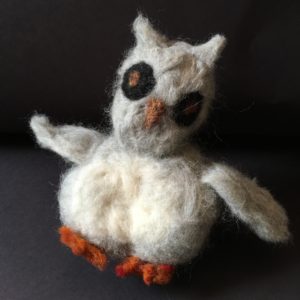 This will be hands on, so bring your ideas and we’ll jump in! Hope to see you there!
This will be hands on, so bring your ideas and we’ll jump in! Hope to see you there!


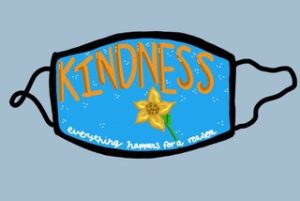
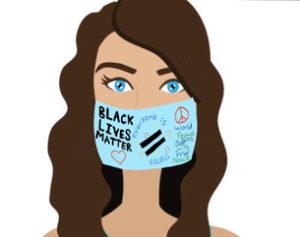
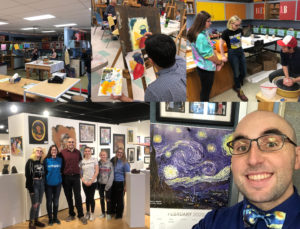
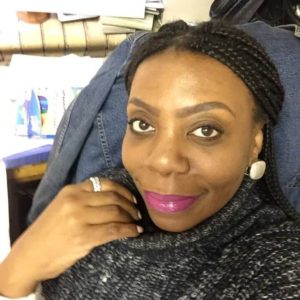
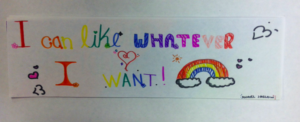

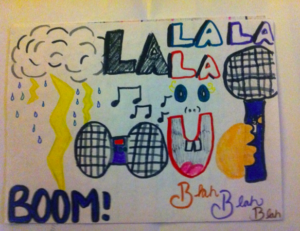
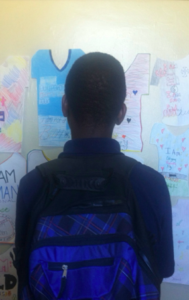 .
. 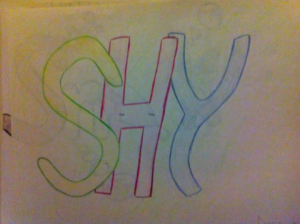
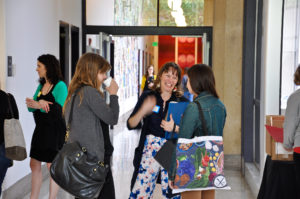
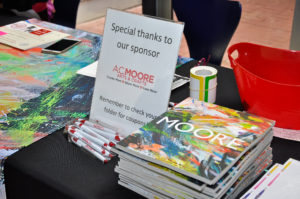
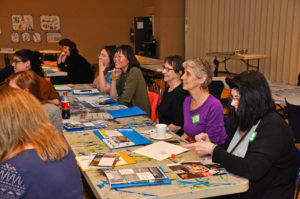
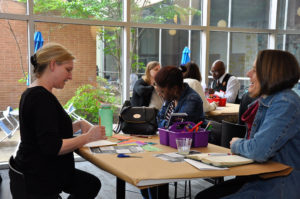
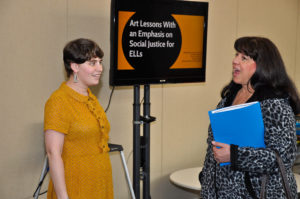
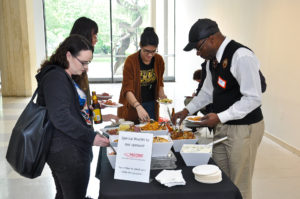
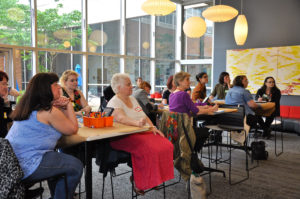

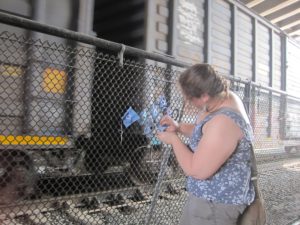
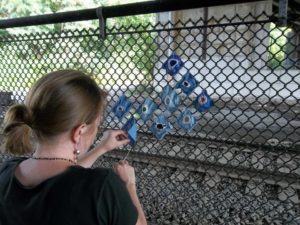
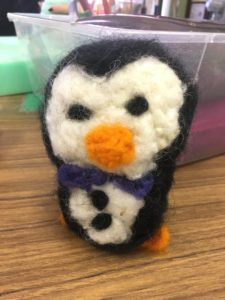
 D5 Creation
D5 Creation